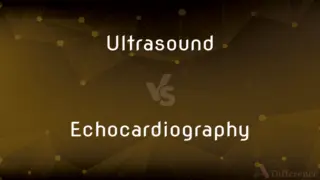Teletherapy vs. Brachytherapy — What's the Difference?
By Urooj Arif & Fiza Rafique — Updated on April 14, 2024
Teletherapy involves treating patients using radiation from a distance, focusing on external radiation delivery, whereas brachytherapy delivers radiation from implants placed close to or inside the tumor.

Difference Between Teletherapy and Brachytherapy
Table of Contents
ADVERTISEMENT
Key Differences
Teletherapy, also known as external beam radiation therapy, utilizes radiation sources located at a distance from the patient's body to target tumors. This method is commonly used for various types of cancers and involves multiple sessions. On the other hand, brachytherapy involves placing radioactive sources directly inside or next to the area requiring treatment, which allows for a higher dose of radiation in a more localized area.
Teletherapy machines emit radiation that must travel through the skin and other healthy tissues to reach the target tumor, potentially causing more widespread side effects. Whereas brachytherapy minimizes radiation exposure to healthy tissues by its proximity to the tumor, thereby reducing some side effects and focusing the radiation more intensely where it is most needed.
The planning and execution of teletherapy often require precise targeting through imaging technologies like CT or MRI scans to ensure the radiation is accurately delivered to the tumor, considering its size and location. Brachytherapy, in contrast, typically involves a one-time placement of radioactive seeds or sources, which remain in place either temporarily or permanently, depending on the cancer type and location.
Patients undergoing teletherapy usually receive treatments over several weeks, involving daily sessions that last a few minutes each. On the other hand, brachytherapy might be completed in fewer sessions with higher doses per session, and in some cases, the treatment duration can be just a few days.
Teletherapy is widely applicable to various parts of the body, including the brain, lungs, and prostate. Brachytherapy is particularly effective for cancers that can be accessed directly, such as cervical, prostate, and breast cancers, offering a tailored treatment approach based on the tumor's physical characteristics.
ADVERTISEMENT
Comparison Chart
Radiation Source
External, distant from the body
Internal, close to or inside the tumor
Treatment Duration
Several weeks, daily sessions
Shorter duration, fewer sessions
Radiation Exposure
To a broader area, including healthy tissues
Primarily to the tumor, sparing healthy tissues
Common Uses
Brain, lung, prostate cancers
Cervical, prostate, breast cancers
Technique Complexity
High, with detailed imaging required
Lower, involves direct placement
Compare with Definitions
Teletherapy
Used primarily for treating large or deep-seated tumors.
Teletherapy is recommended for his brain tumor due to its depth.
Brachytherapy
Often used for specific types of cancer like prostate and breast.
His prostate cancer was treated effectively with brachytherapy.
Teletherapy
The process of delivering radiation therapy from a machine outside the body.
Teletherapy sessions can last from a few minutes to an hour.
Brachytherapy
A form of radiation therapy where radioactive seeds are placed inside or next to the tumor.
Brachytherapy was chosen for her cervical cancer treatment.
Teletherapy
Involves multiple sessions over a course of weeks.
Her teletherapy schedule included 30 sessions over six weeks.
Brachytherapy
Involves either temporary or permanent radioactive implants.
The permanent brachytherapy implants will remain in place.
Teletherapy
Requires precise imaging to target tumors effectively.
Each teletherapy session was preceded by a CT scan for accurate targeting.
Brachytherapy
Can be delivered in fewer, more intense sessions.
Brachytherapy was completed in just three sessions over two weeks.
Teletherapy
A type of cancer treatment using high-energy beams to destroy cancer cells.
The patient received teletherapy for lung cancer over several weeks.
Brachytherapy
Reduces radiation exposure to healthy tissues.
Brachytherapy targeted the tumor without affecting the surrounding tissues.
Teletherapy
Radiotherapy using a source of ionizing radiation at some distance from the patient, typically tens of centimetres. Category:en:Radioactivity
Brachytherapy
Brachytherapy is a form of radiation therapy where a sealed radiation source is placed inside or next to the area requiring treatment. Brachy is Greek for short.
Brachytherapy
Radiotherapy in which the source of radiation is placed close to the surface of the body or within a body cavity.
Brachytherapy
Radiotherapy using radioactive sources positioned within (or close to) the treatment volume, typically with radiopharmaceuticals as opposed to external-beam sources. Category:en:Radioactivity
Common Curiosities
What is brachytherapy?
Brachytherapy is a type of radiation therapy that involves placing radioactive material directly inside or next to the tumor.
How does teletherapy differ from brachytherapy in terms of duration?
Teletherapy typically requires daily sessions over several weeks, while brachytherapy might be completed in fewer sessions over a shorter period.
Can both teletherapy and brachytherapy be used for the same types of cancer?
Both methods can be used for various cancers, but brachytherapy is often preferred for accessible tumors like in cervical or prostate cancer, while teletherapy is suitable for areas like the brain and lungs.
Is brachytherapy more effective than teletherapy?
Effectiveness varies by cancer type. Brachytherapy is particularly effective for tumors that can be treated with high-dose localized radiation, like prostate and cervical cancer, while teletherapy may be preferred for tumors requiring broader coverage.
Which is more precise in targeting tumors, teletherapy or brachytherapy?
Brachytherapy offers more localized and precise treatment by placing radiation sources directly at the tumor site, minimizing exposure to healthy tissues.
What are the side effects associated with teletherapy compared to brachytherapy?
Teletherapy can lead to side effects over a broader area, including skin irritation and fatigue, due to radiation passing through healthy tissues. Brachytherapy tends to have localized side effects, primarily at the site of the radiation source.
Can brachytherapy be used in combination with other treatments?
Yes, brachytherapy is often used alongside other treatments, such as external beam radiation (teletherapy), surgery, or chemotherapy, to enhance effectiveness.
What is teletherapy?
Teletherapy is a form of cancer treatment that involves delivering radiation from a source outside the body to target tumors.
How do doctors decide between using teletherapy or brachytherapy?
The decision depends on the type of cancer, its location, and how accessible the tumor is for implanting radiation directly. Patient's overall health and preferences are also considered.
Which type of radiation therapy is quicker to complete?
Brachytherapy generally has a quicker overall treatment time compared to teletherapy, as it often requires fewer and more intense sessions.
What are the technological requirements for teletherapy?
Teletherapy requires complex machinery, such as linear accelerators and precise imaging technology to target tumors accurately, necessitating significant infrastructure.
Share Your Discovery

Previous Comparison
Ultrasound vs. Echocardiography
Next Comparison
Rare vs. RawAuthor Spotlight
Written by
Urooj ArifUrooj is a skilled content writer at Ask Difference, known for her exceptional ability to simplify complex topics into engaging and informative content. With a passion for research and a flair for clear, concise writing, she consistently delivers articles that resonate with our diverse audience.
Co-written by
Fiza RafiqueFiza Rafique is a skilled content writer at AskDifference.com, where she meticulously refines and enhances written pieces. Drawing from her vast editorial expertise, Fiza ensures clarity, accuracy, and precision in every article. Passionate about language, she continually seeks to elevate the quality of content for readers worldwide.















































